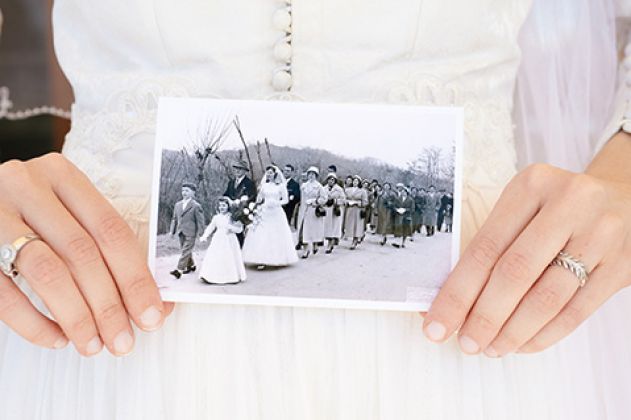I have had an affinity for Venice ever since, as a child, I was taken to the city by my parents during carnival. Years later, I often returned to research a doctoral dissertation on Venetian art. In June of 2012, though, my visit was quite different from previous ones: I was returning to the city I love to celebrate my wedding.
The story of the day begins with the history of a dress. In 1957, my aunt Graziella married in Italy, in her hometown of Liedolo di San Zenone, close to Venice, before immigrating to Canada. Created by Adriana Crespi, a local seamstress who would later design for La Scala in Milan, Graziella’s wedding gown of silk tulle and silk brocade, with each masterful stitch done by hand, was a luxury for a farmer’s daughter. As my aunt noted during our time together in Venice, a book can be written about the dress since it first boarded a ship for Canada in the winter of ’57, survived various moves in Montreal, waited in an attic for years, and, in 2012, returned to Italy for my own wedding luncheon on the rooftop terrace of Venice’s Hotel Danieli.
Over a period of many months before our celebration in Venice, my aunt, an excellent seamstress herself, reassembled the dress to fit me. I had the honour of wearing the gown, and the veil my mother wore on her wedding day, when David and I wed in Montreal in May. A month later, we were celebrating our marriage with family and friends in Italy, bringing the dress back to where it was first made and worn.
The gown made a penultimate trip the day before our reception at the Danieli. With our family from Montreal, we visited the village of Liedolo, where my father was born, where my aunt married, and where, that day, family and friends were gathered in their village square, awaiting our arrival. Wearing the gown, I walked the same streets and stood on the same church steps as my aunt had fifty-five years before.
The morning of our reception in Venice, we gathered at our wonderful hotel, La Calcina, where Ruskin wrote The Stones of Venice, before taking a water taxi along the Grand Canal and the Bacino di San Marco to the Danieli – a glamorous beginning to what would be a magical day. Arriving at the Danieli, we entered the fourteenth-century Palazzo Dandolo to be greeted by our guests, many of whom were already emotional since they had also attended my aunt’s wedding all those years ago. During their speeches, my parents expressed how moved they were that I, a daughter of immigrants, chose to return to the land of their birth to celebrate my wedding.
Marvelling at the beauty of Venice, Charles Dickens once wrote it was the only city he was afraid to describe. I will not attempt to do so here, but, certainly, there cannot be a more breathtaking view of Venice than from the rooftop terrace of the Danieli. One sees the Isola di San Giorgio, the Bacino di San Marco, the Dogana and Church of Santa Maria della Salute, and the recently-restored façade of the Palazzo Ducale with its delicate Gothic tracery. We danced on the terrace overlooking such views and were wrapped in colourful streamers, an Italian tradition known as legati, whimsically intended to “bind” the bridal couple together.
On that glorious afternoon in those magnificent surroundings, as our guests enjoyed looking at photographs we brought with us of my aunt’s wedding, the sense of history, of our family’s history, of the dress, of the Danieli, and of Venice, was palpable. As we left the historic hotel, our guests showered us in rose petals before our gondola ride. As we glided along the canals, I felt the moment and thought that Venice, an improbable city rising from the sea, illogical, impractical, constantly at risk from the tides, and resilient, is like love. What better place to celebrate romantic love and commitment.
As Robert Browning wrote when he lived in Venice, “Open my heart/ and you will see/Engraved inside of it/Italy.” From that day, Venice was now engraved in us.
Liana Bellon teaches literature at Dawson College in Montreal. She earned a Ph.D. from McGill University with a doctoral dissertation that studies three hundred years of souvenir images of Venice, from Canaletto’s paintings to twentieth-century postcards. She can be reached at lbellon@dawsoncollege.qc.ca
Photography credit: Chelsea Gray, Blushing Bride Studio




